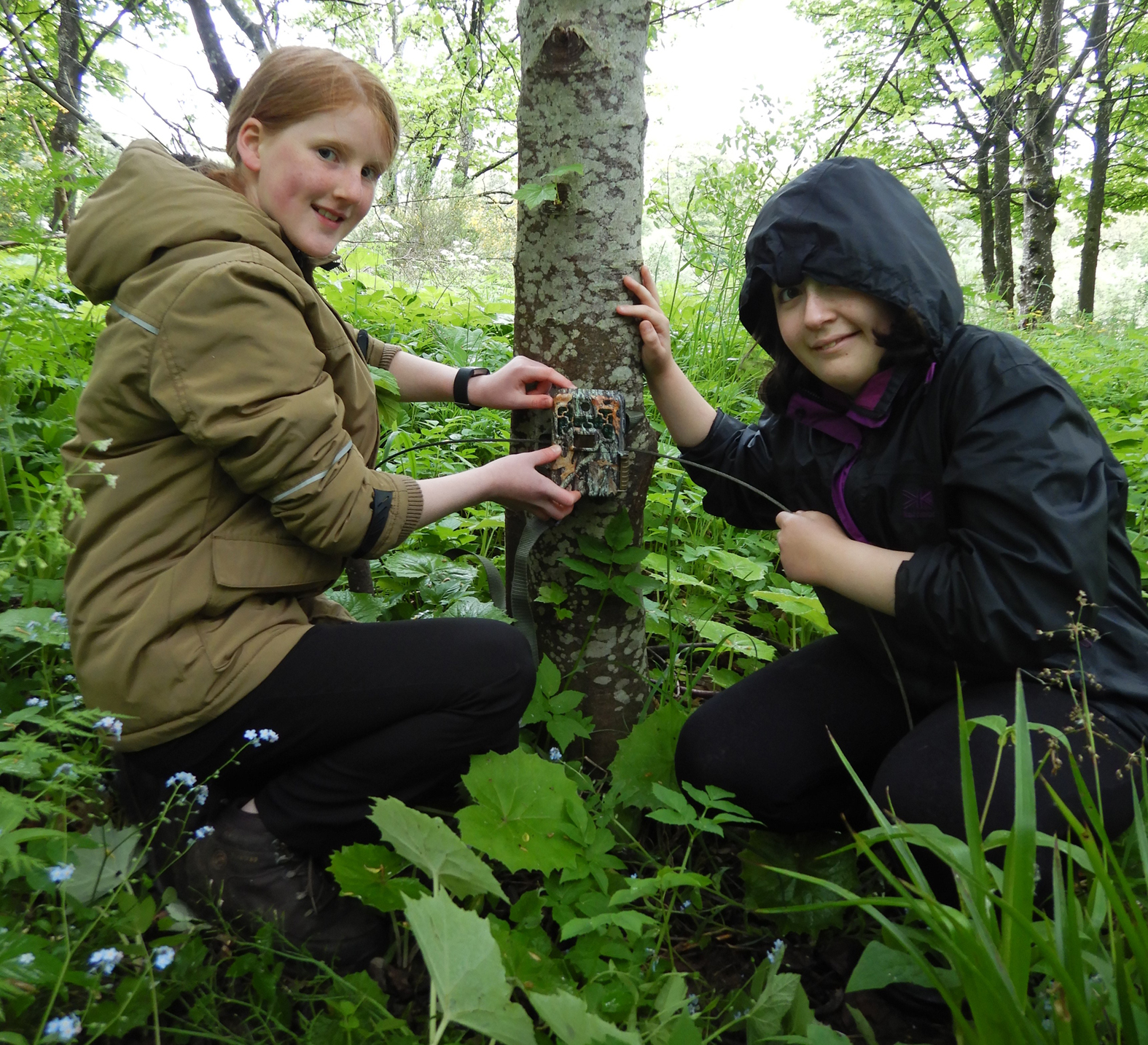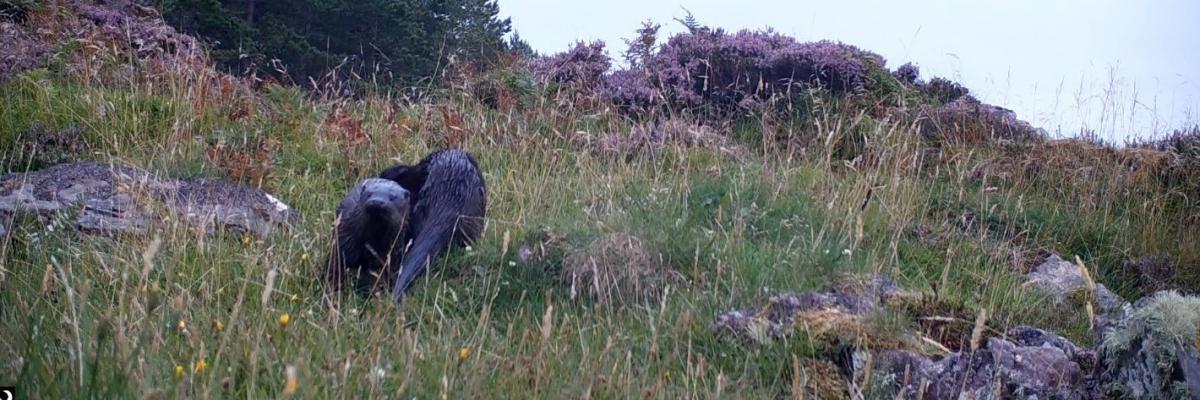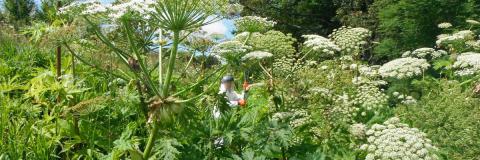Meet some of the life on the river
Wildlife Watcher highlights some of the amazing creatures that live in and around the rivers and lochs in our project area. Our wildlife cameras are set up to help with our mink monitoring project, but quite often they capture some of our iconic native wildlife too!
The river environment is rich in wildlife, both aquatic species that live there and other animals that will visit to drink or hunt for food. Conserving these important freshwater environments is critical for the animals that depend on them and for the wider countryside. Invasive non-native species can have a significant impact on these species and habitats, that's why it is important that we control invasive non-native species across Scotland. Read more about the impacts of invasive species.
Some of our current Wildlife Watcher shots are featured below - to see previous Wildlife Watcher videos and other wildlife trail camera footage have a look at the Scottish Invasive Species Initiative YouTube channel.
We hope you enjoy watching these special glimpses of these creatures going about their business. We'll keep adding to Wildlife Watcher, so check back to see what's new!
Otter
We just had to feature this clip as it's so lovely to capture a family of otters on film.
The European otter (Lutra lutra) is flourishing across Scotland and is found on most river catchments. Otters are secretive, solitary, semi-aquatic mammals that belong to the mustelid family (along with stoats, weasels, pine marten and American mink) and are found either at the coast or inland on rivers. They have brown fur, often pale on the underside, a long slender body with a long thick tail, webbed feet and a broad head with small ears. They swim low in the water, with the head and back barely showing.
'River' otters feed mainly on fish such as trout, salmon and eels, and will also take frogs and toads and occasionally small mammals and birds. They are mainly nocturnal, being most active at dusk and dawn. Their home ranges are large - around 32km for males and 20km for females. 'Coastal' otters (the same species) feed almost exclusively in the sea, and are mainly active during the day. They have much smaller home ranges because of the abundance of fish and crustacean prey in inshore waters. 'Coastal' otters also require access to freshwater in order to keep their fur clean and free of salt.
Otter dens are known as 'holts' and are used for shelter and breeding and may be a burrow, natural hole, pile of rocks or cave. 'Couches' are above-ground structures used for resting or temporary shelter. In Britain, otter cubs, usually in litters of two or three, can be born any time of the year. Cubs are raised by the mother, without help from the male and the juveniles will stay with her for around a year. Otters deposit spraints in prominent places around their territory- these mark the otter's range, defending it's territory and also help neighbours keep in social contact with one another.
In Gaelic, otter is dòbhran, from an old word meaning "water - dog".
Grey Heron
Look at this lovely heron searching for prey - and later finding it!
The Grey heron (Ardea cinerea) is a long-legged predatory wading bird. It is found around all types of water; rivers, lakes, ponds, marshes and the sea coast.
As the video shows herons like to feed on fish, but will take other aquatic creature, such as frogs, small mammals, eels, insects, crustaceans, duckling and even occasionally a small water bird like a Coot. Like you can see in the video they hunt by standing stationary in the water and wait for prey to come within striking distance, using their keen eyesight to spot fish and then use their strong long neck to strike at speed, grasping their prey in their long, dagger like beak. They will also stalk their prey through shallow water.
Fish are swallowed head first (so maybe our herons is trying to turn this fish, without dropping and losing it!). Larger prey are carried to the shore and subdued by being beaten on the ground or stabbed by the bill. Most prey are swallowed whole and the heron will regurgitate pellets of indigestible material such as fur, bones and insect remains. The main hunting times are around dawn and dusk, but it is also active at other times of day.
Although solitary hunters, herons are social birds, living in flocks, at night they will roost in groups in trees or on cliffs. They breed in colonies, know as 'heronries', with numerous nests located in high trees close to lakes, seashores or other wetlands. The same nest is used year after year, getting bigger as more material is added each year.
Hybrid Wildcat
A thirsty cat was the last thing we were expecting to catch on our River-Cam!
At first glance this might look like a Scottish wildcat , but it is actually a hybrid wildcat - the result of interbreeding (hybridisation) between two species - the Scottish wildcat (Felis sylvestris) and a domestic tabby cat.
Hybridisation is the biggest threat to the survival of Scottish wildcats as a species, as interbreeding is causing them to become genetically different and their appearance has subtle changes. 'Pure' Scottish wildcats are now very rare and it is estimated that only 100-300 individuals are left. Scottish wildcats are identified by pelage (coat) markings, and each of 7 key pelage features can be given a score which determines how the cat is classified; a wildcat, a hybrid, or a feral domestic cat. While our cat has some good looking features there are things not quite right, for example, the tail should be bushier and thicker.
A conservation project - Scottish Wildcat Action, is underway which aims to restore viable populations of Scottish wildcats to north Scotland. We are working with this project to try and get more footage of this hybrid cat for their monitoring programme.
Wildcats prefer to live on the woodland edge where a variety of habitats are present; woodland or scrub - which provides shelter and resting places, and open rough land, such as pasture, moorland or riparian areas - for hunting. They are typically active at night, mainly at dusk and dawn. During the day, or in periods of bad weather, cats will lie up in dens located amongst boulders and rocky cairns, in old burrows, holes or tree roots. Wildcats are carnivores and they are well adapted to hunting and catching prey - with night vision, excellent hearing, sensitive whiskers that can detect air movement at night, retractable claws, sharp teeth and strong jaws. Their diet typically consists of rabbits, hares and small mammals but birds, amphibian and insects will also be eaten.
Find out more about Scottish Wildcats
Pine Marten
We got a couple of great clips of Pine martens leaping around near the river...
The Pine marten (Martes martes) is probably one of Scotland's cutest mammals, although relatively rarely seen due to it being mostly nocturnal. They are common across the Highlands of Scotland and have been expanding their range since numbers declined due to persecution in the 19th century.
Pine martens have dark or chestnut brown fur, and a large creamy/yellow throat patch and a large bushy tail. They are part of the mustelid family - the same family as the otter, weasel, stoat and the non-native American mink. They are similar in appearance to the mink, the differences being the mink has darker fur, a smaller pure-white throat patch and smaller less obvious ears.
Pine marten are generally a woodland species, preferring native woodlands but they will also live in conifer plantations and rocky hillsides, they are excellent climbers and tend to live in tree holes or old squirrel dreys or old birds nests. Like other mustelids, pine marten regularly leave their scats on forest trails or in prominent places like boulders to mark their territories.
The pine marten is a carnivore, taking whatever food is available including; small mammals, rabbits, hares, squirrels, birds, eggs, insects, fruit, berries, nuts, fungi, frogs and left overs from rubbish bins and bird tables.
Read more about Pine marten
Red Deer
This young deer seems a bit timid of the water, whereas the older stag seems to enjoy a paddle!
The Red deer (Cervus elaphus) is native to Britain and is our largest land mammal, found throughout northern Scotland and in some areas of England. They can live up to 20 years old, but few deer survive longer than 16 years.
These two in the video seem to have differing opinions of the water, the first deer seems a little unsure of the burn, he dips his toes in, before changing his mind and making a nervous leap across to the other side. In contrast the older male (who is still also a youngster with only basic antlers with little branching) is happy to wade his way slowly down the burn munching the vegetation as he goes.
Most Red deer live in open moor and hill habitats, where the males (stags) and females (hinds) live in separate groups for much of the year. Mating takes place around October/November, a time known as "the rut". Mature stags (over 5 years old) will seek out groups of hinds and attempt to defend them from other stags, resulting in roaring contests, which may escalate to fighting and the locking of antlers to establish who is the dominant stag.
Red deer are herbivores, grazing on grasses and rushes, shrubs such as heather and blaeberry and young trees and sometimes agricultural crops, which brings them into conflict with farmers and foresters. With no natural predators in the wild culling of red deer is undertaken to maintain their health, for sport and meat and to ensure a sustainable balance with the environment.
Native Red deer are at risk from an invasive deer - the Sika deer, which interbreeds and hybridises with the red deer. Sika are very similar in appearance, a key distinguishing factor is the antler shape - in the red deer the angle between the brow tine and the main beam is near to 90º. The first deer in the clip could be a Sika hybrid - the coat spots would not normally be present on a native red deer, but as antlers aren't present it's hard to determine for certain.
Badger
A glimpse at these nocturnal creatures...
The European badger (Meles meles) is common throughout Britain, although due to it's nocturnal habits it's not often seen as it rarely ventures out during daytime.
The badger belongs to the mustelid family - the same family as otters, mink and stoats, but the stocky, low body, short tail and of course the distinctive black and white striped long face make them look quite different in appearance to the other animals in this family.
Badgers live underground in extensive systems of tunnels and nesting chambers - known as setts. They live in social groups of up to 20 adults, although 4-8 adults is more common. The group will occupy a main sett and additional nearby holes, and they will mark this territory using latrines, and will defend it from other badgers. Setts tend to be most common in the shelter of the woodland.
Earthworms are the favourite food of the badger and make up the majority of their diet, however they are omnivorous and will take whatever they find including; insects (watch the opening clip carefully and you'll spot the badger getting a beetle!) fruit, berries and small mammals such as rodents and rabbits.
The Alien!
As we've been celebrating Invasive Species Week this month we thought this wildlife watcher should be this alien creature!
Of course, it's not really an alien - it is a native animal - a bat.
Obviously from this clip we can't tell which species of bat it is, but given the habitat and the way the bat is moving and hunting at head height our best guess would be that it is a Pipistrelle bat.
Pipistrelles (Pipistrellus pipistrellus) are the commonest species of bat and are found in a wide variety of habitats, from countryside to urban locations. They appear fast and jerky in flight as they dodge around pursuing small insects which they catch and eat 'on the wing' - i.e.. while they are flying. Rivers and water courses are a favourite hunting ground for bats, due to the plentiful insect supply. Bats are nocturnal - hunting mostly at dusk and dawn.
Bats are social creatures, living in roosts - which can be found in and around houses (usually behind tiles, soffit or eaves boards etc) or in tree holes and crevices. A summer roost might average around 75 bats, while a maternity roost might have a few hundred bats. In winter bats move to a cooler winter roost to hibernate such as a crevice in a building, bridge or tree, where they hibernate either singly or in small numbers.
Bat's use a technique called "echolocation" to locate prey and navigate in the dark. As they fly they make a shouting sound and they listen to the returning echoes with a special part of their ear, allowing them to build up a picture of anything ahead of them - including the shape and size of any insect and which way it is going.
Did you know?
- Bats are the only mammal that can fly
- A bat's wing is actually a hand adapted for flight (like a webbed foot)
- A pipistrelle bat is small enough to fit inside a matchbox
- A pipistrelle bat weighs only 3-8g - that's the same as a 20p coin
- One pipistrelle bat can eat up to 3,000 insects in one night
- There are 1,300 species of bats worldwide
Find out more about bats with the Bat Conservation Trust

Are you a Wildlife Watcher?
We'd love to see any great video clips of wildlife that you've captured near your local river!
We've also been helping some local schools to try their hand at setting out trail cameras and capturing wildlife footage.
You can share any clips on social media or send them to us at [email protected]
You may also be interested in
Our invasive species page has the answers.




